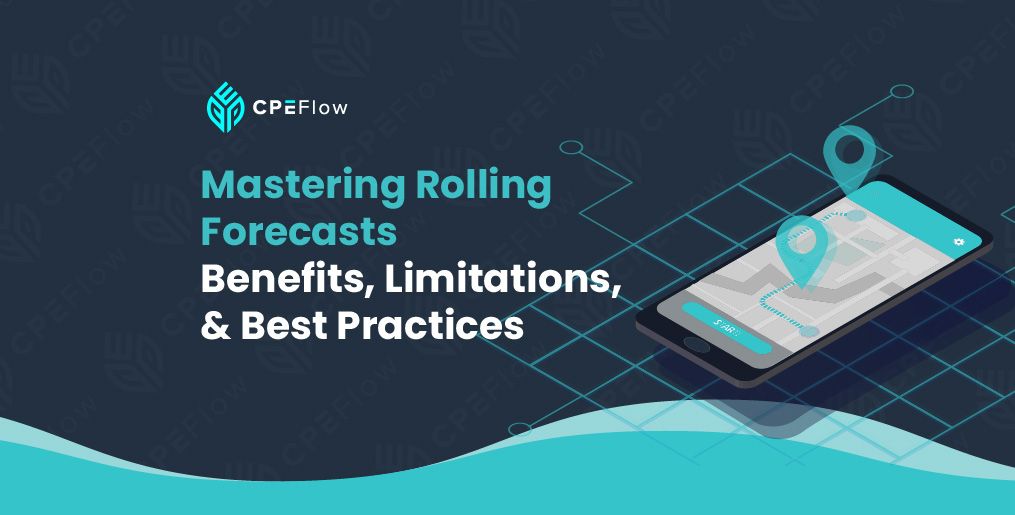Mastering Rolling Forecasts: Benefits, Limitations, & Best Practices
Jun 3
/
Nathan Liao, CMA

Relying on traditional annual budgets is like navigating with an old paper map. It gives you a general sense of direction but doesn’t adapt to unexpected changes like roadblocks, traffic jams, or detours.
On the other hand, rolling forecasts function more like a GPS app. They update in real time, allowing you to adjust your route quickly whenever conditions change.
Rolling forecasts give businesses a clearer line of sight by allowing them to continually update financial projections based on current data. Companies can shift direction as needed rather than sticking to a fixed roadmap made months ago.
This flexible approach enables them to spot risks and opportunities sooner and make better, data-informed decisions throughout the year.
If you want to understand and apply rolling forecasts effectively, CPE Flow's Mastering Rolling Finances course is the perfect starting point.
What is a Rolling Forecast?
A rolling forecast is a financial model that helps companies plan using the most current data. Unlike static annual budgets, rolling forecasts are updated regularly, usually every month or quarter, to reflect real-time changes so your business can adapt quickly.
This type of forecasting works by dropping a completed period and adding a new one while keeping the time horizon consistent. For example, a company might start with a forecast covering January 2025 to December 2025. Once January ends, the forecast rolls forward to cover February 2025 through January 2026. This creates a constantly moving window into the future.
The main goal of a rolling forecast is to improve flexibility and accuracy in your business planning. It helps you anticipate shifts in revenue, expenses, cash flow, and other key metrics based on what is actually happening in the market. By staying aligned with real-time trends and financial data, businesses can respond faster to change, reduce risks, and make more informed decisions.
Budget vs. Forecast: What's the Difference?
Static budgets and rolling forecasts are both useful tools for financial planning, but they serve different purposes.
A static budget is a fixed financial plan for a specific period, usually built using data from the previous year. Companies use this information to set targets for revenue, expenses, and other key metrics. While static budgets can help set expectations and measure performance, they don't change even when market conditions do.
Budgets are often quicker and easier to create but can quickly become outdated. This makes it harder for businesses to stay flexible and responsive when unexpected changes occur.
On the other hand, a rolling forecast is built for flexibility. It provides a forward-looking view of the company's future based on real-time data rather than fixed goals set months earlier. As each period ends, a new one is added, so the forecast always extends the same amount of time into the future.
Creating and maintaining rolling forecasts can be more complex and time-consuming than working with static budgets. However, they allow businesses to respond more quickly and make better data-driven decisions.
Get Exclusive Access & Special Discounts!
Get early bird access to new CPE courses and exclusive discounts only shared with our email subscribers.
Rolling Forecasts Pros and Cons
Rolling forecasts offer some incredible benefits. However, just like any financial planning tool, they also have their own limitations.
Understanding both the advantages and limitations can help you decide whether rolling forecasts are the right fit for your organization.
Benefits of Rolling Forecasts
Some benefits of rolling forecasts include the following:
- Greater accuracy in financial planning: Rolling forecasts incorporate the most up-to-date data as they are updated regularly. This makes the projections a more accurate reflection of real-world conditions.
- Better risk management: By continuously monitoring performance and trends, businesses can spot potential risks and react quickly before they become bigger problems. This is especially crucial if these issues are time-sensitive.
- Faster, more informed decisions: With a more current view of financial data, teams can make smarter day-to-day decisions that support their long-term goals.
- More agility and flexibility: Unlike static budgets, rolling forecasts allow companies to quickly adjust plans in response to market fluctuations, internal changes, or new opportunities and risks.
- Support for strategic planning and growth: Rolling forecasts give leaders a longer line of sight, making it easier to plan for growth and assign their resources strategically.
Limitations of Rolling Forecasts
Rolling forecasts come with their own set of challenges, especially when it comes to time and resources.
They need to be updated often, which means companies need to put in extra effort, invest in the right tools, and hire or train people with the right skills. Without that, the process can become inefficient and lead to mistakes.
It can be even harder to manage rolling forecasts in larger companies.
Gathering accurate, up-to-date data across multiple departments isn’t always easy. Since the forecast relies on input from teams like sales, operations, and HR, getting everyone on board is key. Without strong buy-in from all departments, the company's forecasts may be incomplete.
Gathering accurate, up-to-date data across multiple departments isn’t always easy. Since the forecast relies on input from teams like sales, operations, and HR, getting everyone on board is key. Without strong buy-in from all departments, the company's forecasts may be incomplete.
That said, rolling forecasts can still be an incredibly useful tool for companies that invest in the right people and processes.
Key Steps to Implementing a Rolling Forecast
Transitioning to a rolling forecast model requires planning, collaboration, and the right tools.
Here are five key steps to help you implement rolling forecasts successfully.
1. Clarify Your Objectives
It's important to clearly define what insights your organization hopes to gain from rolling forecasts.
Start by clarifying what you want the forecast to achieve. This could mean using it to manage resources more effectively, spot potential risks ahead of time, or guide long-term investments. It also helps to identify the key stakeholders so you know who will be using the forecasts to make decisions.
When your forecasting efforts are tied directly to your business goals, the process becomes far more useful.
2. Define Scope and Structure
Decide on the appropriate level of detail, forecast horizon, and update frequency.
For instance, will your forecasts cover the entire organization or be broken down by department?
To establish parameters for the process, you should also determine how often forecasts will be updated and how far into the future the time horizon will be.
Choosing a structure that strikes a balance between accuracy and manageability will help ensure the process remains sustainable and delivers ongoing value.
3. Build Internal Alignment
Rolling forecasts usually need input from different parts of the business, so it’s a good idea to involve key people early on.
Bringing together contributors from various departments, such as finance, operations, HR, sales, and marketing, helps ensure the forecast is complete and accurate.
4. Leverage Quality Data and Automation
The next step is to start preparing the rolling forecast.
Your forecast is only as good as the data behind it. Use reliable, up-to-date information and aim to minimize manual data entry where possible.
Your company may leverage automation tools to streamline updates and data collection, reduce errors, and free up your team's time to focus on analysis and strategy rather than managing spreadsheets.
5. Review, Adapt, and Communicate
Once your rolling forecast is up and running, it's important to establish a regular review process.
Compare forecasts with actual results, investigate any variances, and determine what actions are needed to improve future accuracy. Treat the forecast as a living tool that evolves alongside your business.
Another important step is sharing the forecast insights with team leaders and stakeholders. A good way to do this is through visual dashboards or simple summary reports that match what each group needs to see.
To turn those insights into action, you can assign follow-up tasks to the right teams. This keeps everyone accountable and helps ensure the whole organization is working toward the same goals.
Rolling Forecast Best Practices
These best practices can help businesses get the most out of their rolling forecasts while minimizing the risk of inaccuracies or wasted time and resources.
1. Use a Driver-Based Approach
Driver-based forecasting focuses on the factors that have the biggest impact on your business and that you can actually influence, like pricing, demand, or production costs.
Instead of relying too much on past trends or assumptions, this approach helps you focus on what really drives results.
By targeting what matters most, your forecasts become more useful for making smart, timely decisions.
2. Monitor Forecast Accuracy with Variance Analysis
Forecasts should be tested regularly to ensure they stay accurate and relevant.
Use variance analysis to compare your projections with actual results. This allows you to identify where assumptions need to be revised or improved. Larger variances often signal a less accurate forecast and indicate the need for adjustments.
By tracking performance over time, you can fine-tune both the model and the forecasting process, leading to more reliable results.
3. Invest in the Right People and Tools
Maintaining a rolling forecast takes a team that knows the business inside and out and can communicate clearly across departments.
Having the right tools matters just as much. Spreadsheets alone can be slow and error-prone. Forecasting software can help you save time, make data collection easier, and keep your numbers accurate.
Mastering Rolling Forecasts for Strategic Decision-Making
Mastering rolling forecasts isn't just about producing reports and crunching numbers.
Without a solid process in place, rolling forecasts can quickly become time-consuming, inaccurate, and a waste of time and resources. To make them truly effective, you need the right techniques and tools that can turn your data into smarter business decisions.
That's exactly why we created the Mastering Rolling Forecasts course. In this self-paced program, you'll learn how to implement rolling forecasts effectively, perform meaningful variance analysis, and select the right tools to improve the process. You'll also earn NASBA-approved CPE credits as you build these skills from the comfort of your own home!
Thank you for reading,

Nathan Liao, CMA
Empty space, drag to resize
Nathan Liao, a Certified Management Accountant, educator, and influential business figure in the accounting industry, has dedicated over a decade to supporting more than 82,000 accounting and finance professionals in their pursuit of the CMA certification. As the visionary founder of CMA Exam Academy and CPE Flow, Nathan is committed to delivering premier online training solutions for the next generation of accounting and finance professionals.
Explore Our Self-Paced CPE Courses
CPE Flow
© 2022 - 2025 CPE Flow, LLC. All Rights Reserved.
Refund & Complaint Policies
Requests for refunds must be made in writing within 5 days of purchasing the course. No refunds or credits will be provided after this point or if the final assessment is completed. CPE Flow issues refunds within 30 days in the same format as the payment was received. The refund amount is based on the timeframe in which the request was submitted (see table).
| Request Timeframe |
Refund/Credit Amount |
|
≤ 2 Hours |
100% Refund* |
|
> 2 Hours ≤ 48 Hours |
90% Refund* or 100% Credit** |
|
> 48 Hours ≤ 5 Days |
0% Refund or 50% Credit** |
* If a credit card was used for purchase, the 3.5% credit card fee will be deducted from the refund amount.
**Credit can be applied towards the same offering at a later date or a different offering.
For complaints or concerns, please email support@cpeflow.com
